SNVS875O August 2012 – December 2015 LM3262
PRODUCTION DATA.
- 1 Features
- 2 Applications
- 3 Description
- 4 Revision History
- 5 Pin Configuration and Functions
- 6 Specifications
- 7 Detailed Description
- 8 Application and Implementation
- 9 Power Supply Recommendations
- 10Layout
- 11Device and Documentation Support
- 12Mechanical, Packaging, and Orderable Information
6 Specifications
6.1 Absolute Maximum Ratings
over operating free-air temperature range (unless otherwise noted)(1)(2)| MIN | MAX | UNIT | ||
|---|---|---|---|---|
| VIN to SGND | −0.2 | 6 | V | |
| PGND to SGND | −0.2 | 0.2 | V | |
| EN, VCON, BPEN | (SGND − 0.2) | (VIN + 0.2) | V | |
| FB, SW | (PGND − 0.2) | (VIN + 0.2) | V | |
| Continuous power dissipation(3) | Internally limited | |||
| Junction temperature, TJ-MAX | 150 | °C | ||
| Maximum lead temperature (soldering, 10 sec) | 260 | °C | ||
| Storage temperature, Tstg | −65 | 150 | °C | |
(1) Stresses beyond those listed under Absolute Maximum Ratings may cause permanent damage to the device. These are stress ratings only, which do not imply functional operation of the device at these or any other conditions beyond those indicated under Recommended Operating Conditions. Exposure to absolute-maximum-rated conditions for extended periods may affect device reliability.
(2) All voltages are with respect to the potential at the GND pins.
(3) Internal thermal shutdown circuitry protects the device from permanent damage. Thermal shutdown engages at TJ = 150°C (typical) and disengages at TJ = 130°C (typical).
6.2 ESD Ratings
| VALUE | UNIT | |||
|---|---|---|---|---|
| V(ESD) | Electrostatic discharge | Human-body model (HBM), per ANSI/ESDA/JEDEC JS-001(1) | ±2000 | V |
| Charged-device model (CDM), per JEDEC specification JESD22-C101(2) | ±1250 | |||
(1) JEDEC document JEP155 states that 500-V HBM allows safe manufacturing with a standard ESD control process.
(2) JEDEC document JEP157 states that 250-V CDM allows safe manufacturing with a standard ESD control process.
6.3 Recommended Operating Conditions
over operating free-air temperature range (unless otherwise noted)(1)| MIN | MAX | UNIT | |||
|---|---|---|---|---|---|
| Input voltage, VIN | 2.5 | 5.5 | V | ||
| Recommended load current | PWM mode | 0 | 800 | mA | |
| Bypass mode | 0 | 1000 | mA | ||
| Junction temperature, TJ | –30 | 125 | °C | ||
| Ambient temperature, TA(2) | −30 | 90 | °C | ||
(1) All voltages are with respect to the potential at the GND pins
(2) In applications where high-power dissipation and/or poor package thermal resistance is present, the maximum ambient temperature may have to be de-rated. Maximum ambient temperature (TA-MAX) is dependent on the maximum operating junction temperature (TJ-MAX-OP = 125°C), the maximum power dissipation of the device in the application (PD-MAX), and the junction-to ambient thermal resistance of the part/package in the application (RθJA), as given by the following equation: TA-MAX = TJ-MAX-OP – (RθJA × PD-MAX).
6.4 Thermal Information
| THERMAL METRIC(1) | LM3262 | UNIT | |
|---|---|---|---|
| YFQ (DSBGA) | |||
| 9 PINS | |||
| RθJA | Junction-to-ambient thermal resistance | 85 | °C/W |
(1) For more information about traditional and new thermal metrics, see the Semiconductor and IC Package Thermal Metrics application report, SPRA953.
6.5 Electrical Characteristics
Unless otherwise noted, all specifications apply to the Typical Application Circuit with: VIN = EN = 3.6 V andBPEN = NC = 0 V. All typical (TYP) limits apply for TA = TJ = 25°C, and all minimum (MIN) and maximum (MAX) apply over the full operating ambient temperature range (−30°C ≤ TA = TJ ≤ +90°C), unless otherwise specified.(1)(2)(3)
| PARAMETER | TEST CONDITIONS | MIN | TYP | MAX | UNIT | |
|---|---|---|---|---|---|---|
| VFB, MIN | Feedback voltage at minimum setting | PWM mode, VCON = 0.16 V(4) | 0.38 | 0.4 | 0.42 | V |
| VFB, MAX | Feedback voltage at maximum setting | PWM mode, VCON = 1.44 V, VIN = 4 V | 3.55 | 3.6 | 3.65 | V |
| ISHDN | Shutdown supply current | EN = SW = VCON = FB = BPEN = NC =0 V(5) | 0.1 | 1 | µA | |
| IQ_PWM | PWM mode quiescent current | PWM mode, No switching VCON = 0.13 V, FB = 1 V(6) |
650 | 795 | µA | |
| IQ_SLEEP | Low-power sleep mode | EN = VIN, BPEN = NC = 0V, SW = tri state VCON < 0.8 V, FB = 2.05 V(7) |
25 | µA | ||
| IQ_ECO | ECO mode quiescent current | ECO mode, No switching VCON = 0.8 V, FB = 2.05 V(6) |
60 | µA | ||
| ILIM,P | PFET switch peak current limit | See(8) | 1300 | 1450 | 1600 | mA |
| ILIM, BP | BPFET switch peak current limit | VFB = VIN – 1 V | 310 | 400 | mA | |
| ƒOSC | Internal oscillator frequency | 5.7 | 6 | 6.3 | MHz | |
| VIH | EN, BPEN logic high input threshold | 1.2 | V | |||
| VIL | EN, BPEN logic low input threshold | 0.4 | V | |||
| Gain | VCON to VOUT gain | 0.16 V ≤ VCON ≤ 1.44 V(9) | 2.5 | V/V | ||
| IVCON | VCON pin leakage current | VCON = 1 V | –1 | 1 | µA | |
| VBP, NEG | Auto bypass detection negative threshold | VCON = 1.2 V (VOUT-SET = 3 V) VIN = 3.2 V, RL = 6 Ω (IOUT = 500 mA)(10) |
165 | 200 | 235 | mV |
| VBP, NEG | Auto bypass detection positive threshold | VCON = 1.2 V (VOUT-SET = 3 V) VIN = 3.25 V, RL = 6 Ω (IOUT = 500 mA)(11) |
215 | 250 | 285 | mV |
| IBP, SLEW | BPEN = High, Forced bypass | 1600 | mA | |||
(1) All voltages are with respect to the potential at the GND pins.
(2) Minimum and maximum limits are specified by design, test, or statistical analysis.
(3) The parameters in the electrical characteristics table are tested under open loop conditions at VIN = 3.6 V unless otherwise specified. For performance over the input voltage range and closed-loop results, refer to Typical Characteristics.
(4) All 0.4-V VOUT specifications are at steady-state only.
(5) Shutdown current includes leakage current of PFET.
(6) Iq specified here is when the device is not switching. For operating input current at no load, refer to Typical Characteristics.
(7) FB has 200 kΩ to SGND.
(8) Current limit is built-in, fixed, and not adjustable.
(9) Care should be taken to keep the VCON pin voltage less than the VIN pin voltage as this can place the device into a manufacturing test mode.
(10) Entering bypass mode, VIN is compared to the programmed output voltage (2.5 × VCON). When VIN − (2.5 × VCON) falls below VBP,NEG longer than TBP,NEG, the bypass FET turns on, and the switching FET turns on.
(11) Bypass mode is exited when VIN − (2.5 × VCON) exceeds VBP,POS longer than TBP,POS, and PWM mode resumes. The hysteresis for the bypass detection threshold VBP,POS − VBP,NEG is always positive and is approximately 50 mV.
6.6 System Characteristics
The following parameters are specified by design and verifications providing the component values in the Typical Application Circuit are used. These parameters are not verified by production testing. Minimum (MIN) and maximum (MAX) values are specified over the ambient temperature range TA = −30°C ≤ TA ≤ +90°C and over the VIN range = 2.5 V to 5.5 V, unless otherwise specified; L = 0.5 μH, DCR = 50 mΩ, CIN = 10 μF, 6.3 V, 0402 (1005), COUT = 4.7 μF, 6.3 V, 0402 (1005). For bench evaluation, see (1).| PARAMETER | TEST CONDITIONS | MIN | TYP | MAX | UNIT | |
|---|---|---|---|---|---|---|
| D | Maximum duty cycle | MODE = LOW | 100% | |||
| IOUT | Maximum output current capability | 2.5 V ≤ VIN ≤ 5.5 V 2.5 × VCON ≤ VIN – 285 mV |
800 | mA | ||
| 2.5 V ≤ VIN ≤ 5.5 V 2.5 × VCON ≤ VIN – 165 mV, bypass mode |
1000 | |||||
| VOUT linearity | VCON = 0.16 V to 1.44 V | 0 mA ≤ IOUT ≤ 800 mA(2) | –3% | 3% | ||
| –50 | 50 | mV | ||||
| η | Efficiency | VIN = 3.8 V, VOUT = 0.8 V IOUT = 10 mA, ECO mode |
71% | |||
| VIN = 3.8 V, VOUT = 2.5 V IOUT = 200 mA, PWM mode |
92% | |||||
| VIN = 3.8 V, VOUT = 3.4 V IOUT = 500 mA, PWM mode |
93% | |||||
| LINE_tr | Line transient response | VIN = 3.6 V to 4.2 V, TR = TF = 10 µs, IOUT = 100 mA, VOUT = 0.8 V |
50 | mVpk | ||
| LOAD_tr | Load transient response | VIN = 3.1/3.6/4.5 V, VOUT = 0.8 V IOUT = 50 mA to 150 mA TR = TF = 10 µs, |
50 | mVpk | ||
(1) When the LM3262 device is being evaluated apart from a normal system design or on a PCB other than the TI LM3262 evaluation module, user should ensure that a 50-µF to 100-μF ceramic input capacitor is added to the PCB to keep input voltage from sagging during rapid load transitions.
(2) Linearity limits are ±3% or ±50 mV, whichever is larger. VOUT is monotonic in nature with respect to VCON input.
6.7 Timing Requirements
| MIN | NOM | MAX | UNIT | ||
|---|---|---|---|---|---|
| TVCON_TR | VOUT rise time VCON change to 90%; VIN = 3.7 V, VOUT = 1.4 V to 3.4 V 0.1 µs < VCON_TR < 1 µs, RL = 12 Ω |
5 | µs | ||
| VOUT fall time VCON change to 10%; VIN = 3.7 V, VOUT = 3.4 V to 1.4 V 0.1 µs < VCON_TR < 1 µs, RL = 12 Ω |
5 | µs | |||
| TON | Turnon time (time for output to reach 95% final value after Enable low-to-high transition) EN = low-to-high, VIN = 4.2 V , VOUT = 3.4 V IOUT ≤ 1 mA, COUT = 4.7 µF |
50 | µs | ||
| TBP, NEG | Auto bypass detect negative threshold delay time(1) | 10 | µs | ||
| TBP, POS | Auto bypass detect positive threshold delay time(2) | 0.1 | µs | ||
(1) Entering bypass mode, VIN is compared to the programmed output voltage (2.5 × VCON). When VIN − (2.5 × VCON) falls below VBP, NEG longer than TBP, NEG, the bypass FET turns on, and the switching FET turns on.
(2) Bypass mode is exited when VIN − (2.5 × VCON) exceeds VBP, POS longer than TBP, POS, and PWM mode resumes. The hysteresis for the bypass detection threshold VBP, POS − VBP, NEG is always positive and will be approximately 50 mV.
6.8 Typical Characteristics
VIN = EN = 3.6 V, L = 0.5 µH, CIN = 10 µF, COUT = 4.7 µF and TA = 25°C, unless otherwise noted.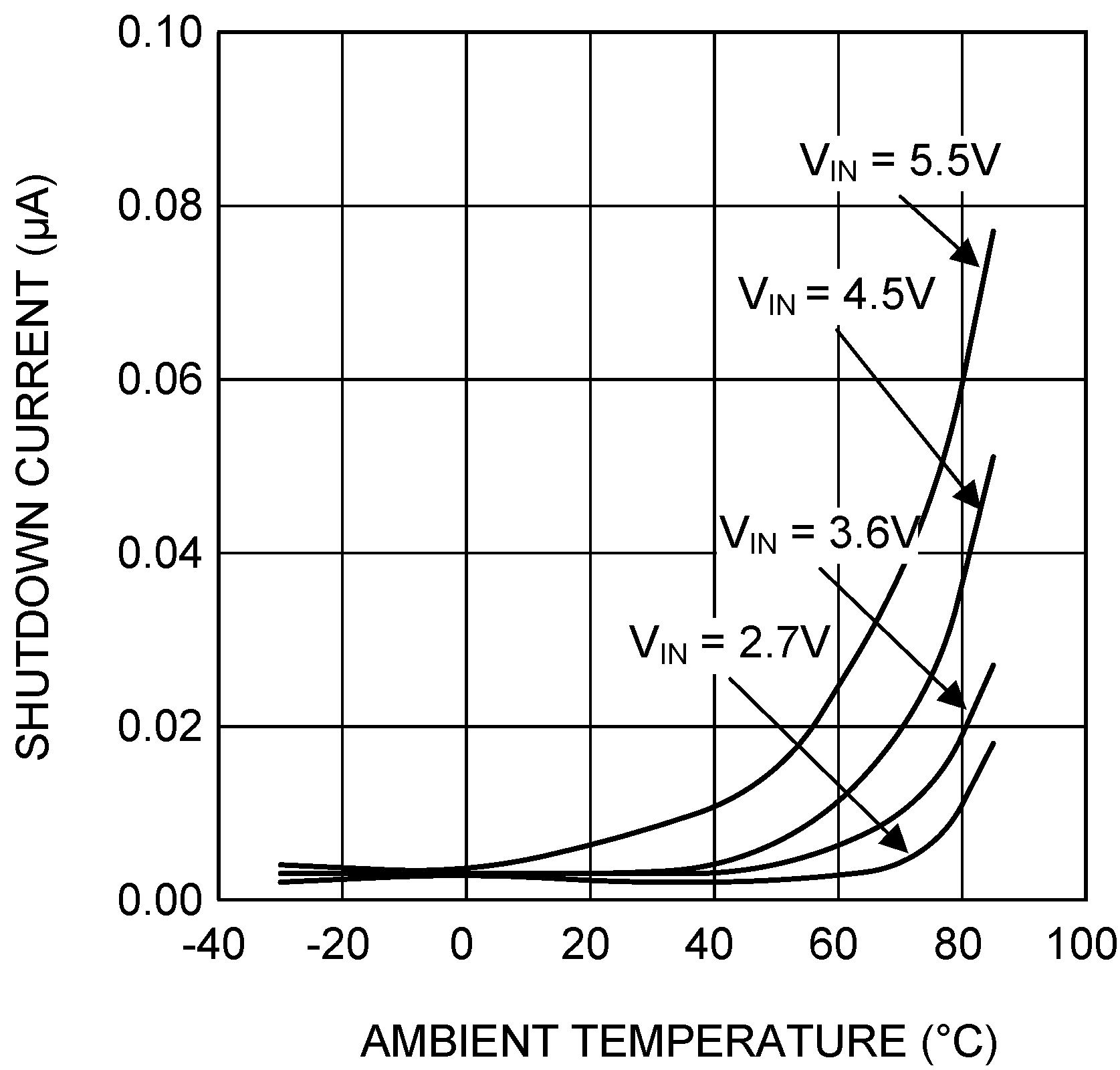
| SW = VCON = EN = BPEN = 0V | ||
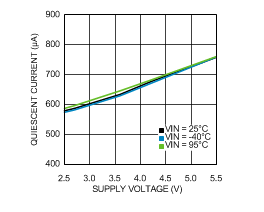
| No Switching | FB = 1 V | VCON = 0.13 V |
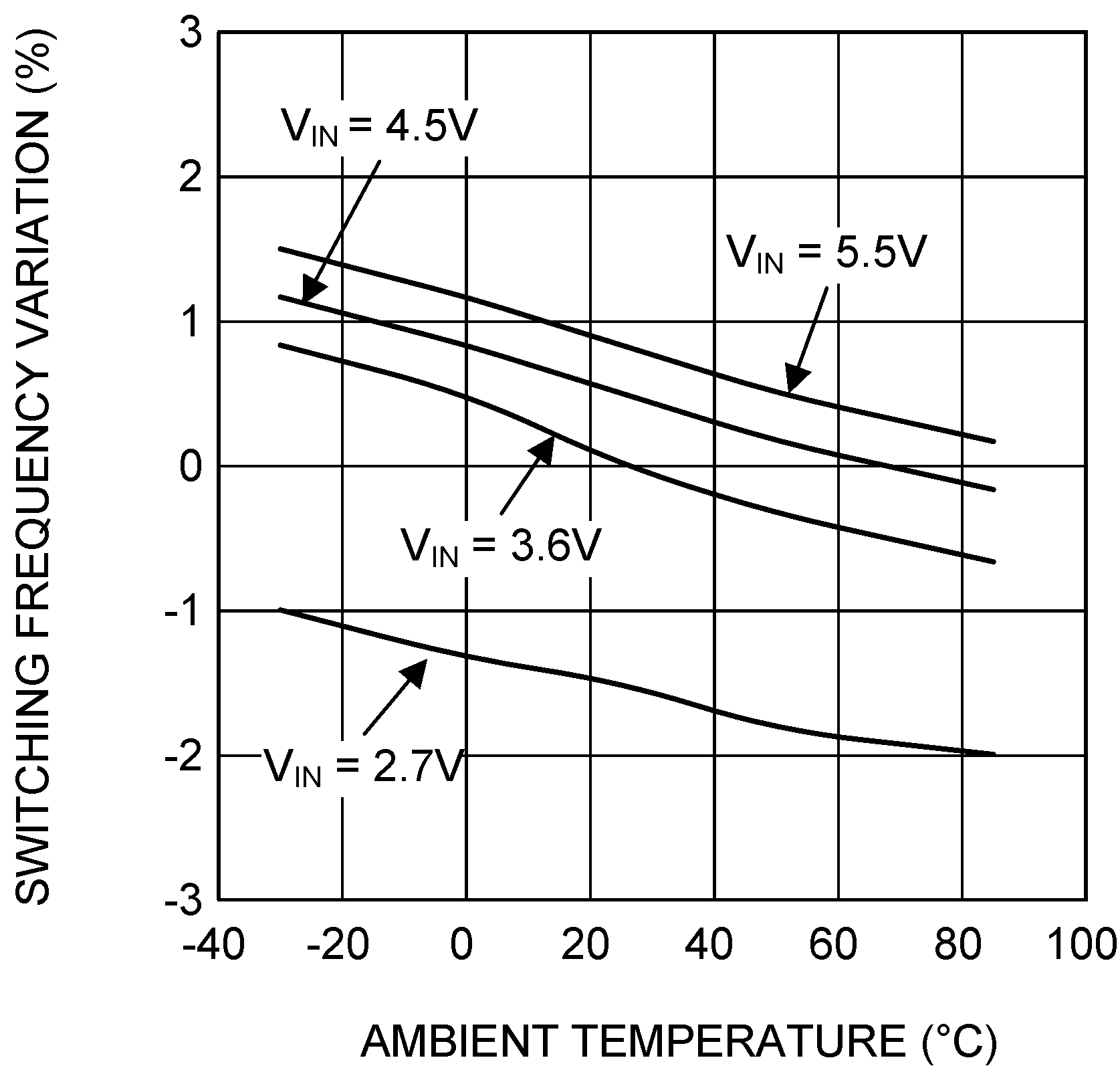
| VOUT = 2 V | IOUT = 200 mA |
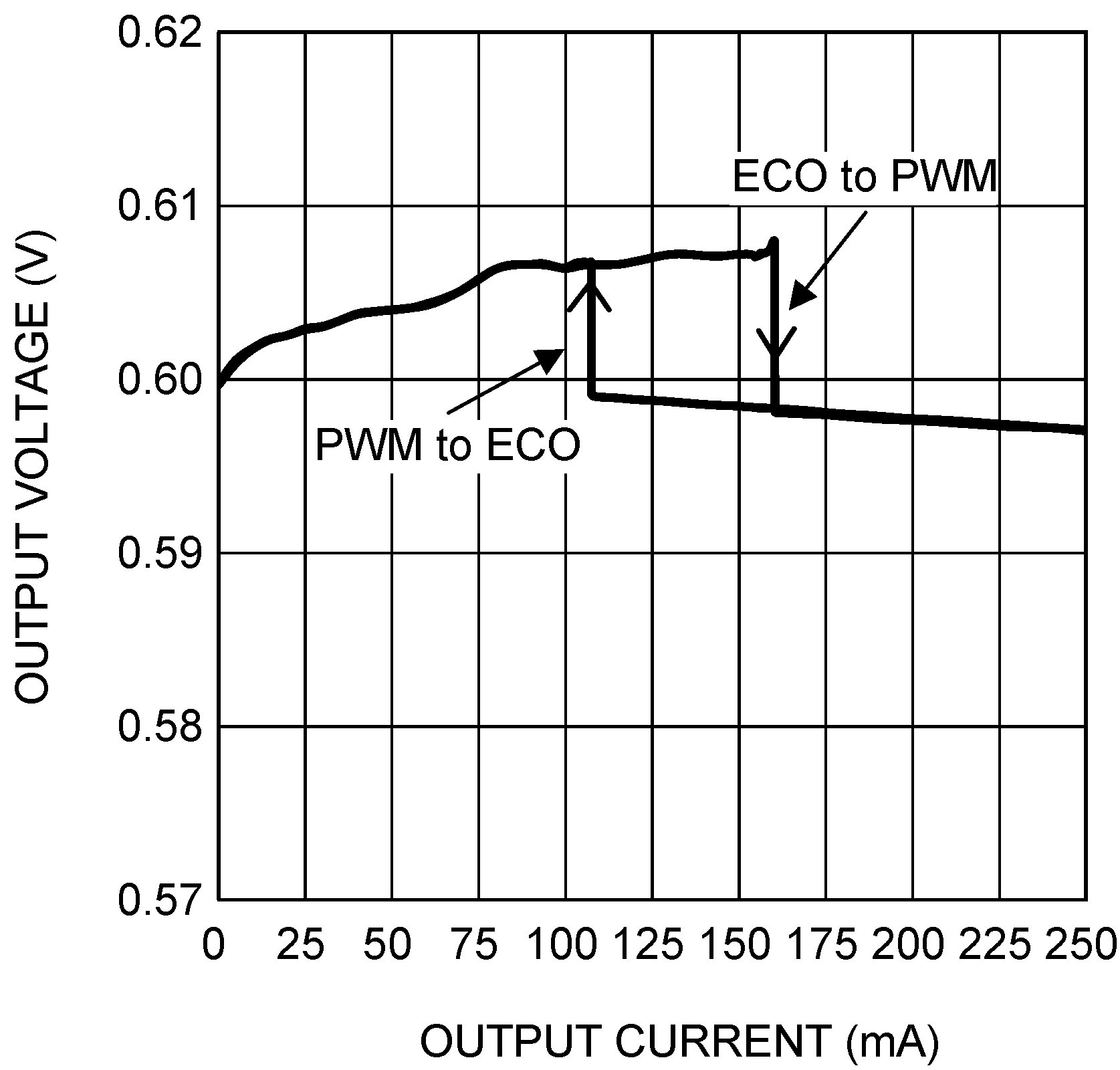
| VIN = 3.8 V | VOUT = 0.6 V |
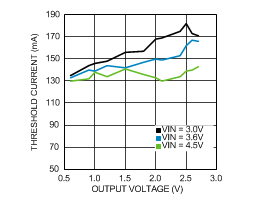
vs Output Voltage

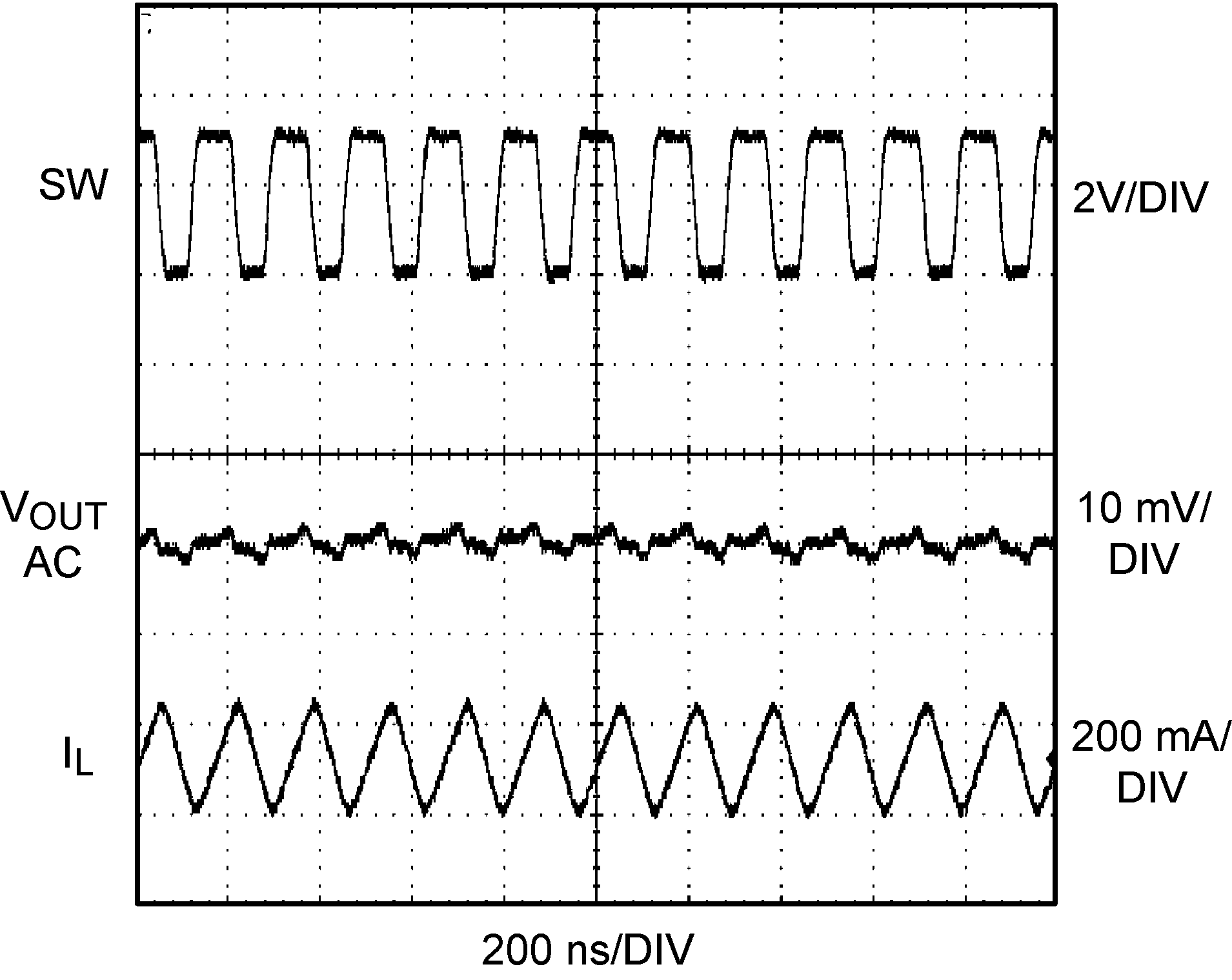
| VIN = 3.6 V | VOUT = 2 V | IOUT = 200 mA |
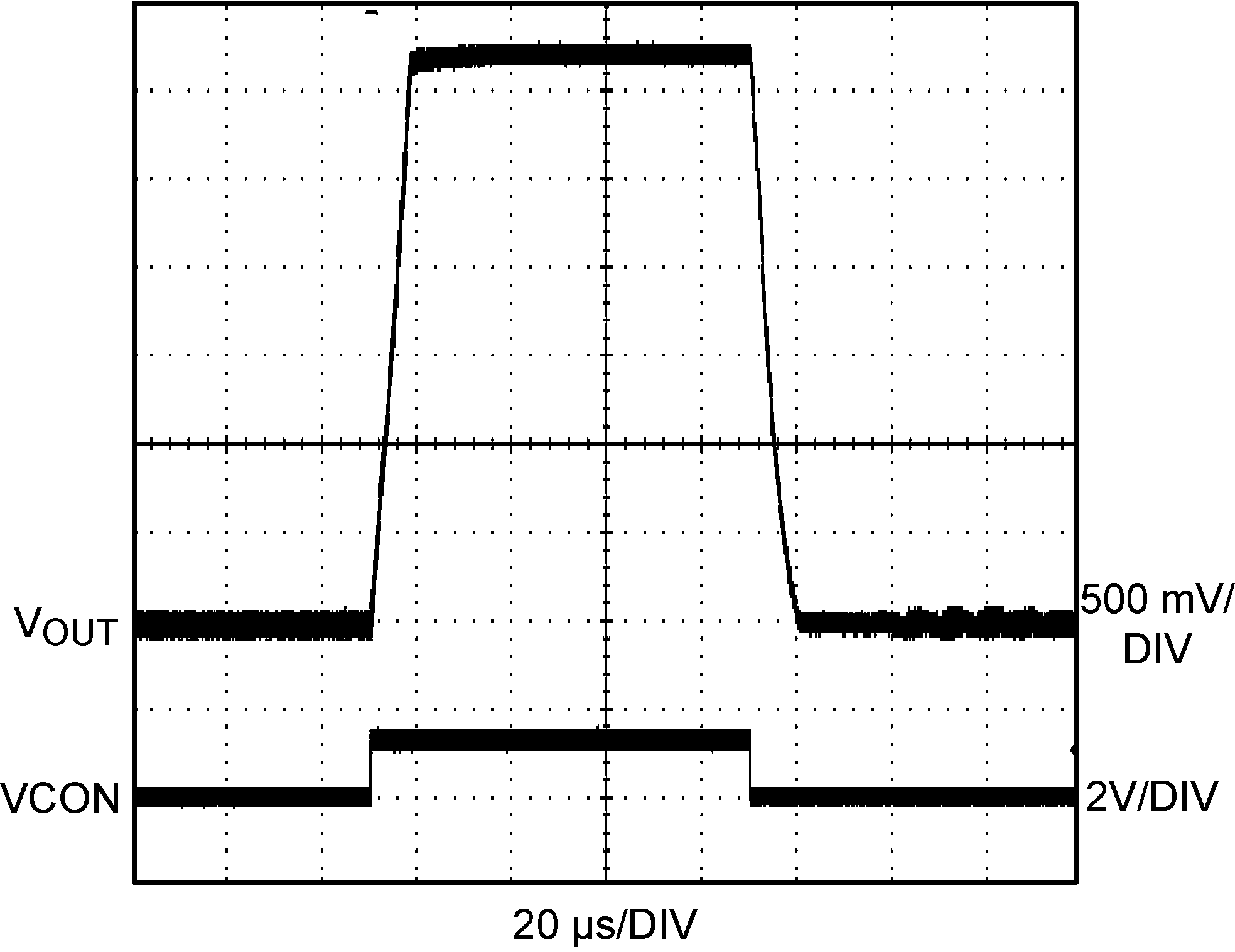
| VIN = 4 V | VOUT = 0.4 V to 3.6 V | RLOAD = 10 Ω |
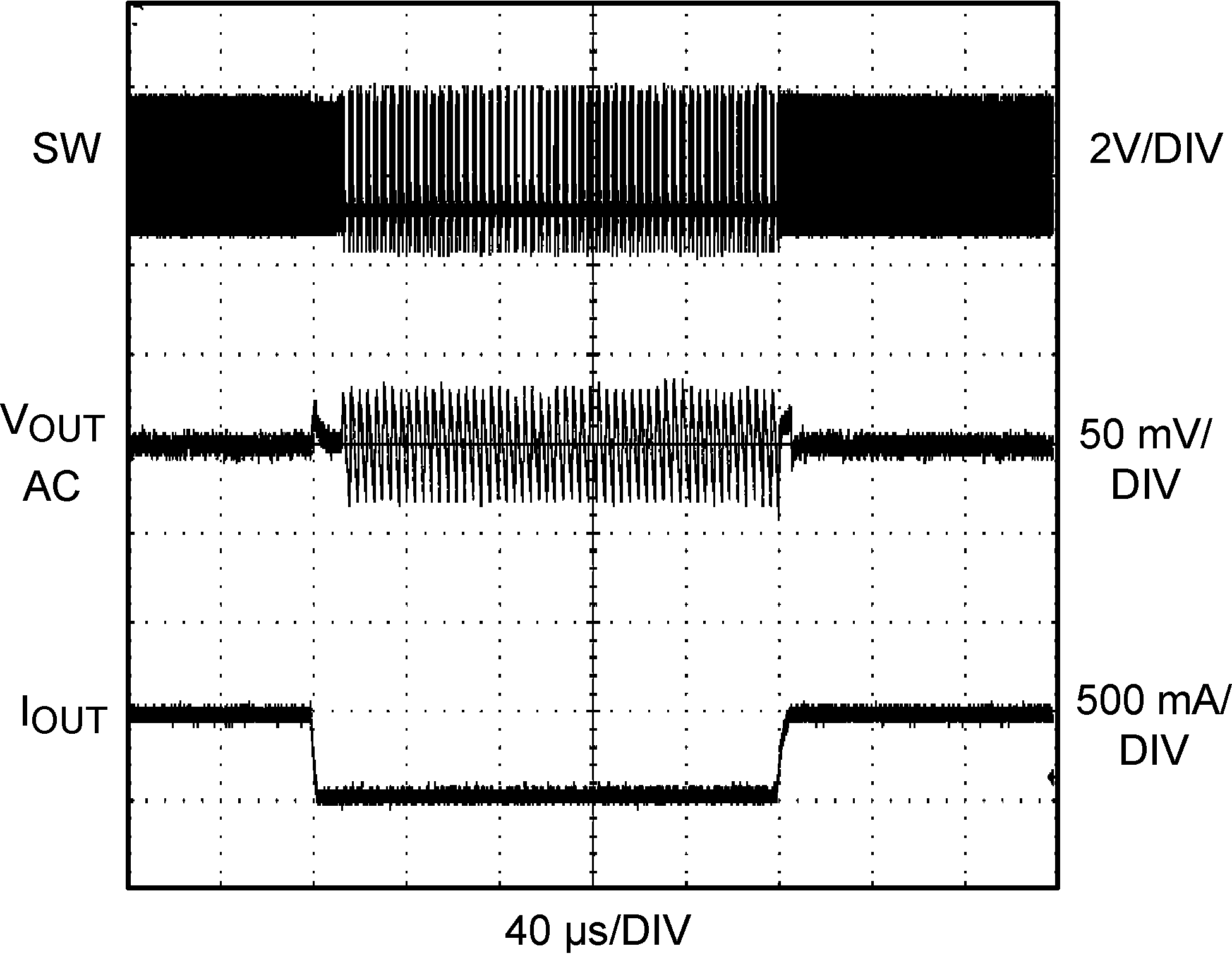
| VIN = 3.6 V | VOUT = 0.5 V | IOUT = 500 mA to 60 mA |
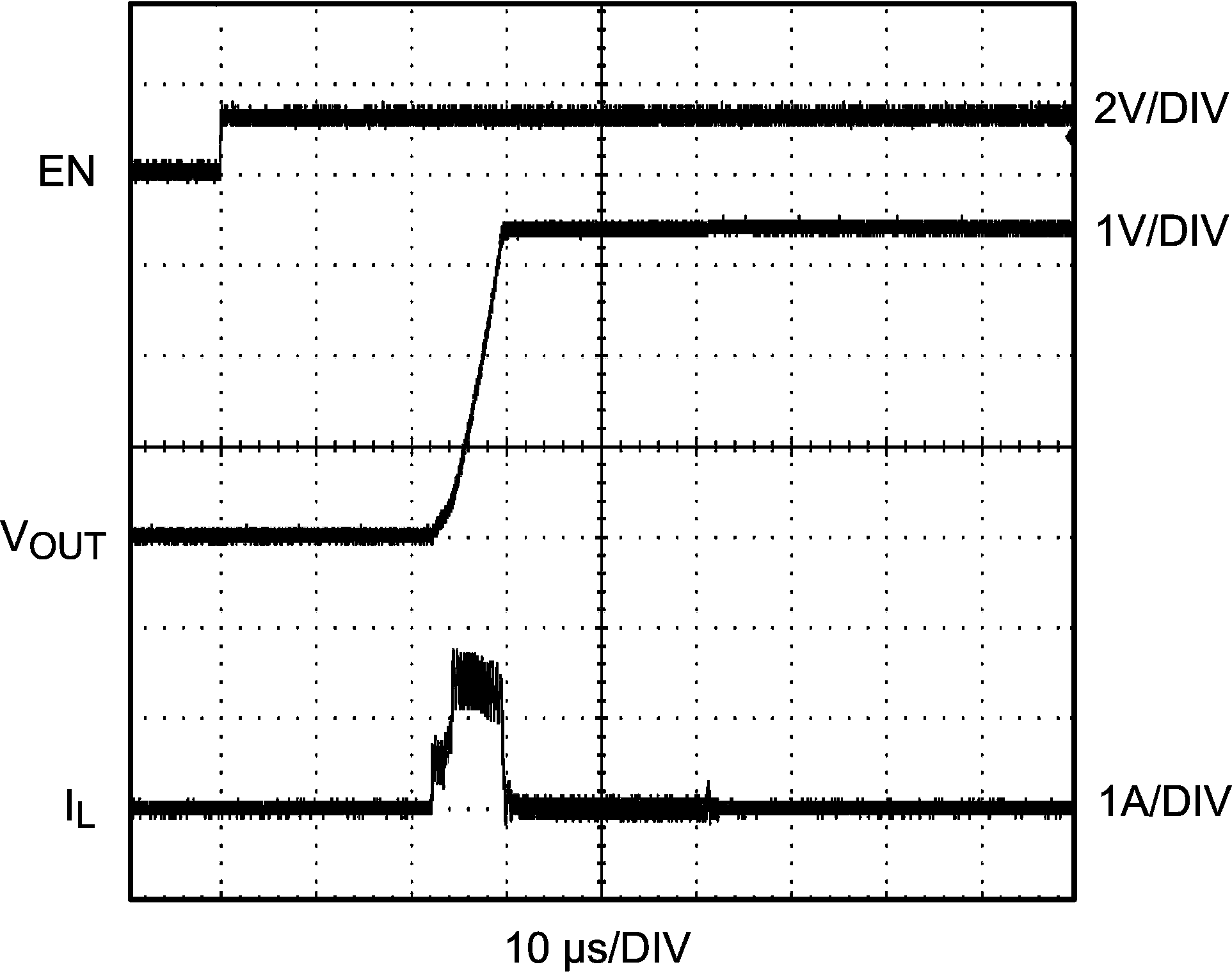
| VIN = 4.2 V | VOUT = 3.4 V | RLOAD = 3.6 kΩ |
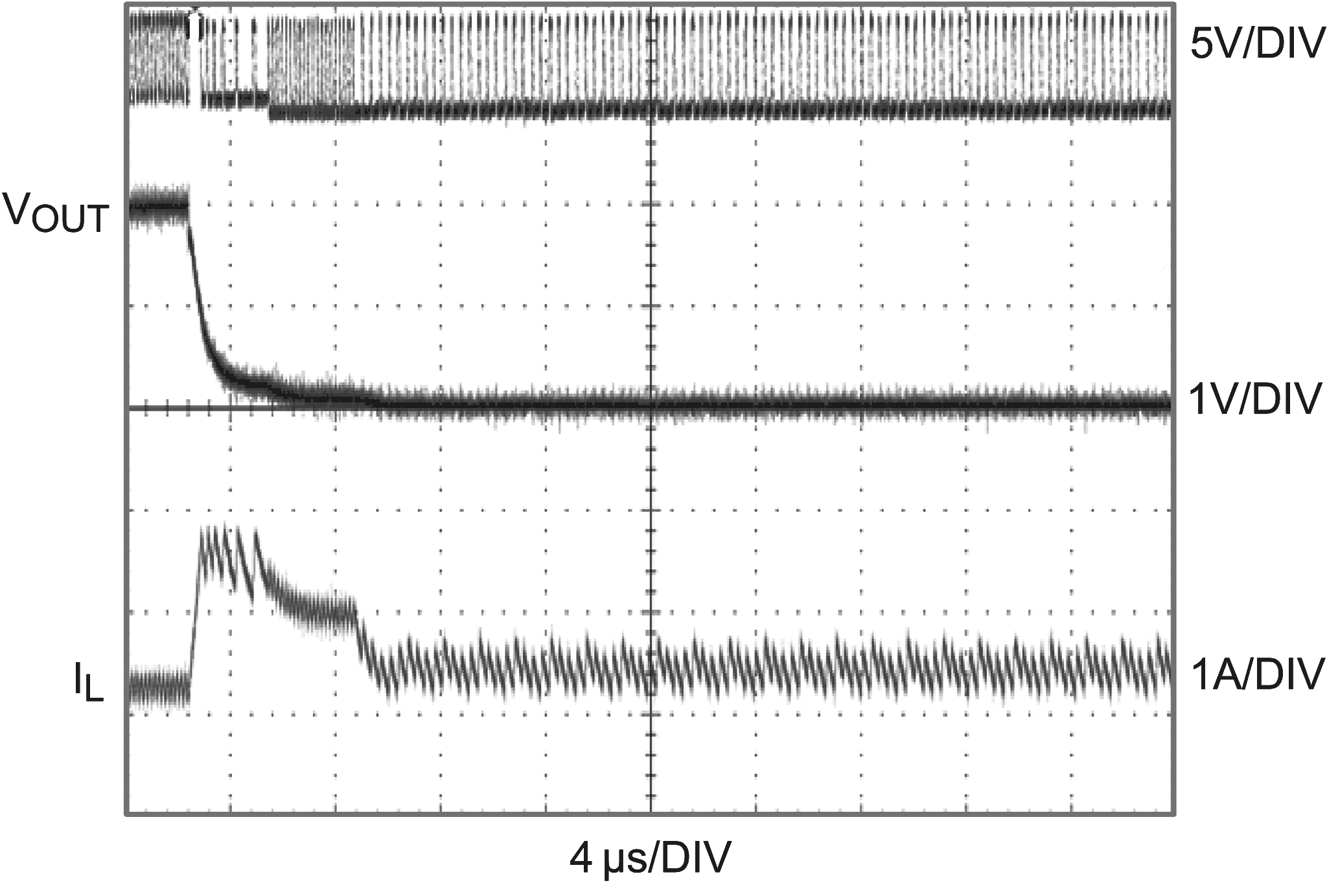
| VOUT = 2 V | RLOAD = 10 Ω→ 0 Ω | |

| VCON < 80 mV | EN = VIN | BPEN = 0 |
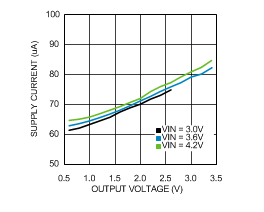
| Closed Loop | Switching | No load |
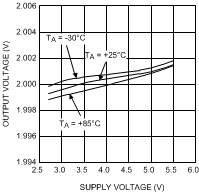
| VOUT = 2 V | RLOAD = 10 Ω |
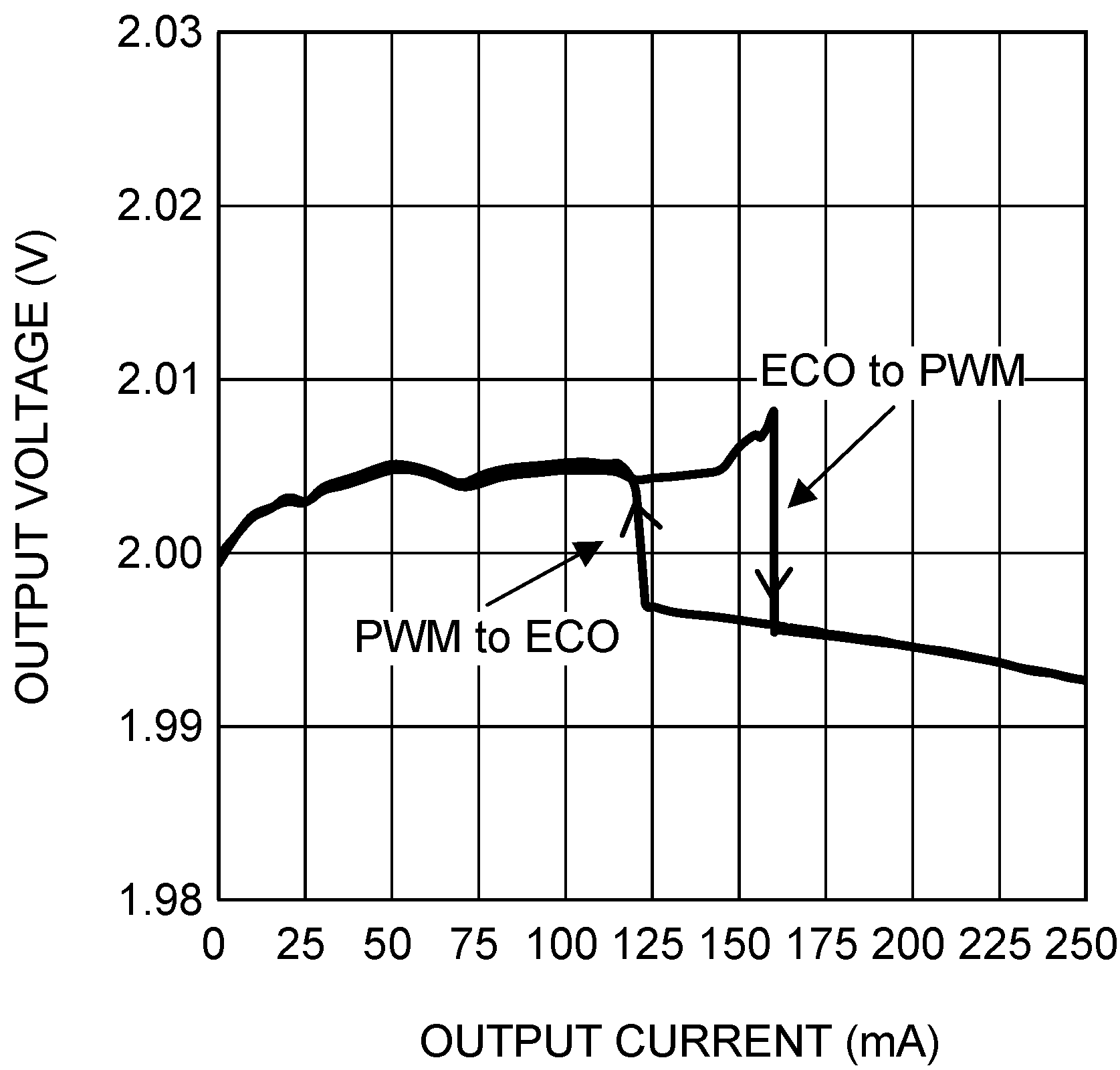
| VIN = 3.8 V | VOUT = 2 V |
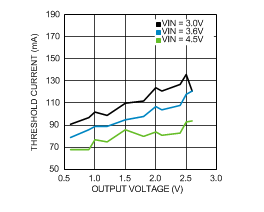
vs Output Voltage
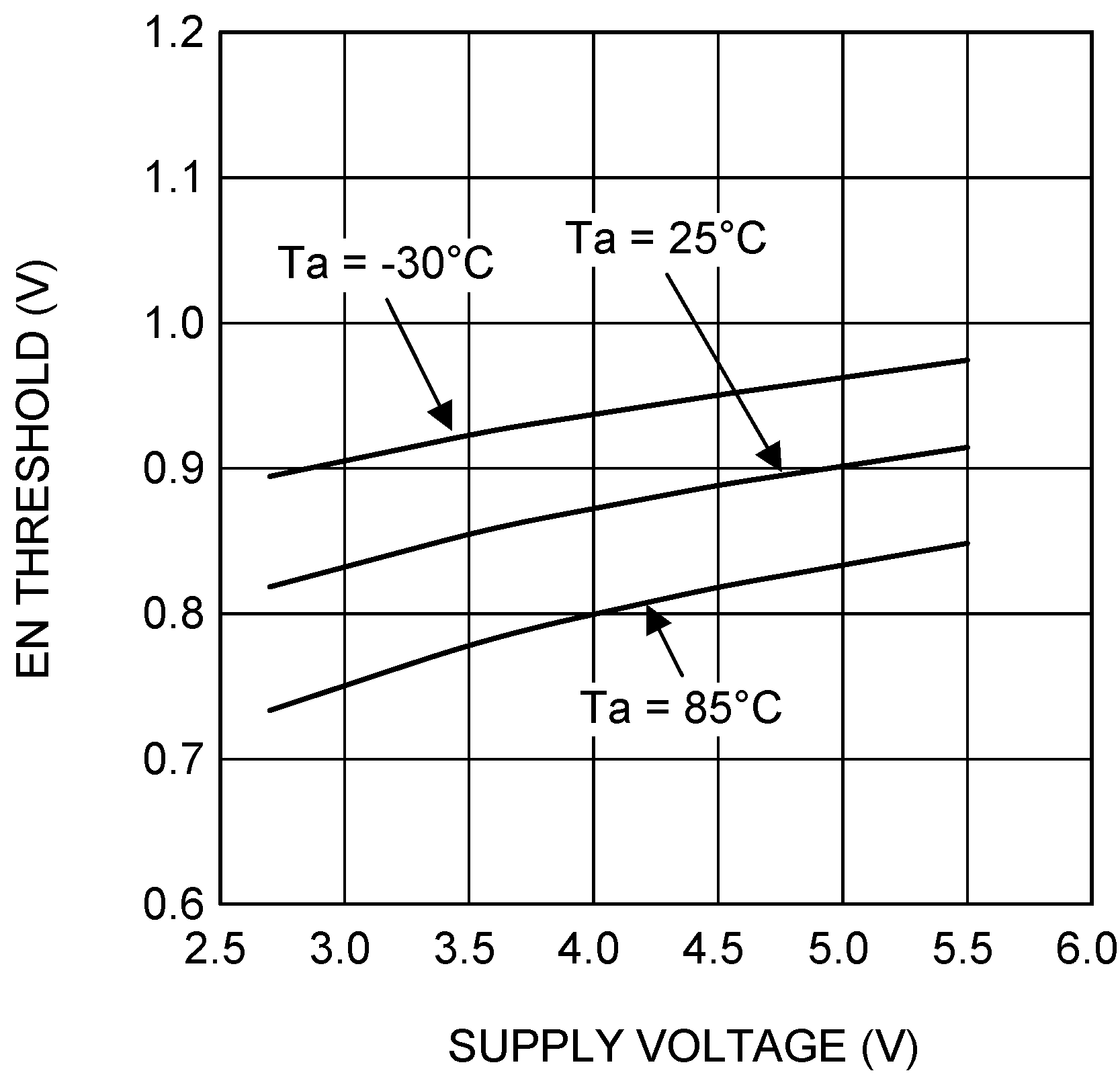
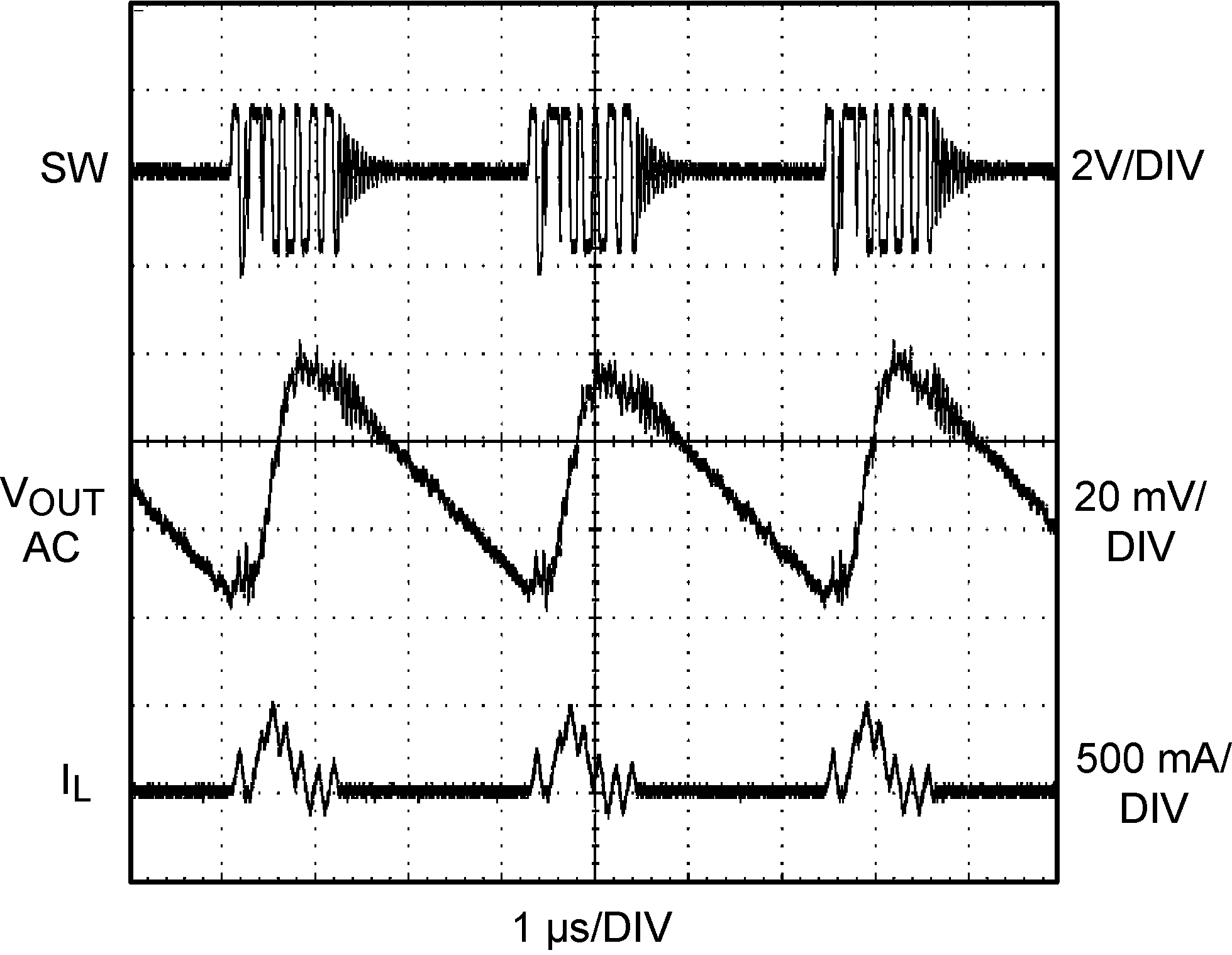
| VOUT = 2 V | IOUT = 50 mA |
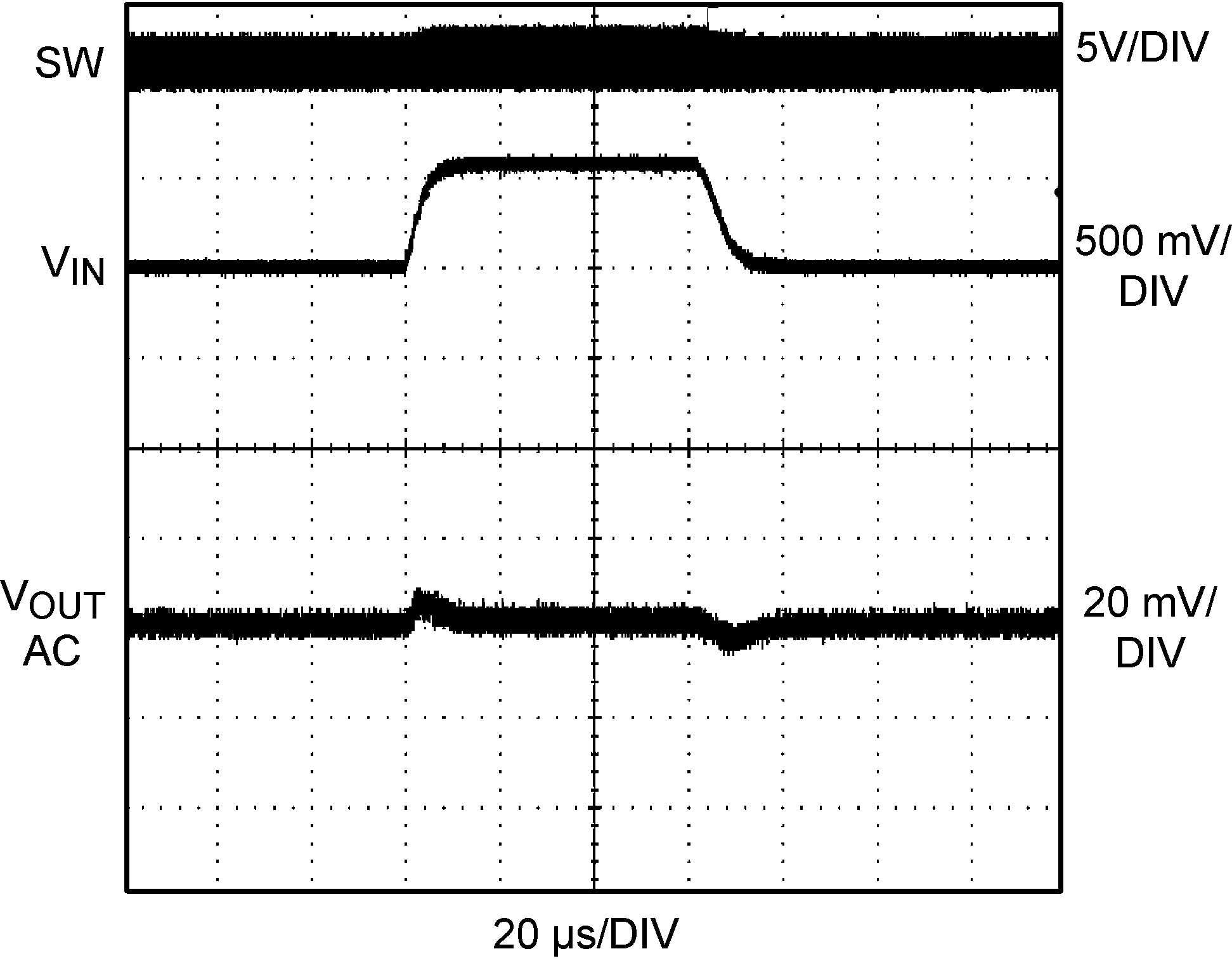
| VIN = 3.6 V to 4.2 V | VOUT = 0.6 V | IOUT = 750 mA |
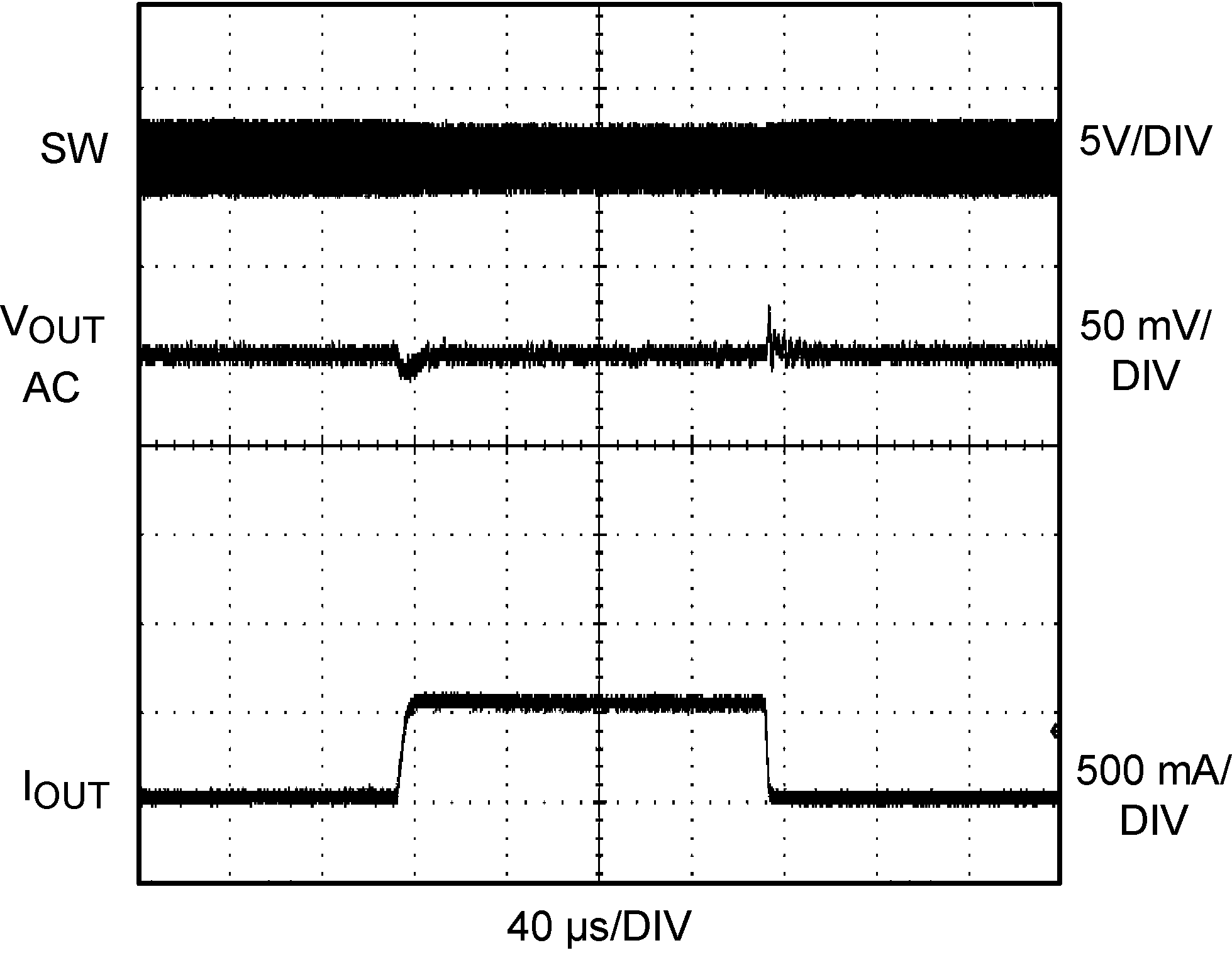
| VIN = 4.2 V | VOUT = 3.1 V | IOUT = 200 mA to 750 mA |
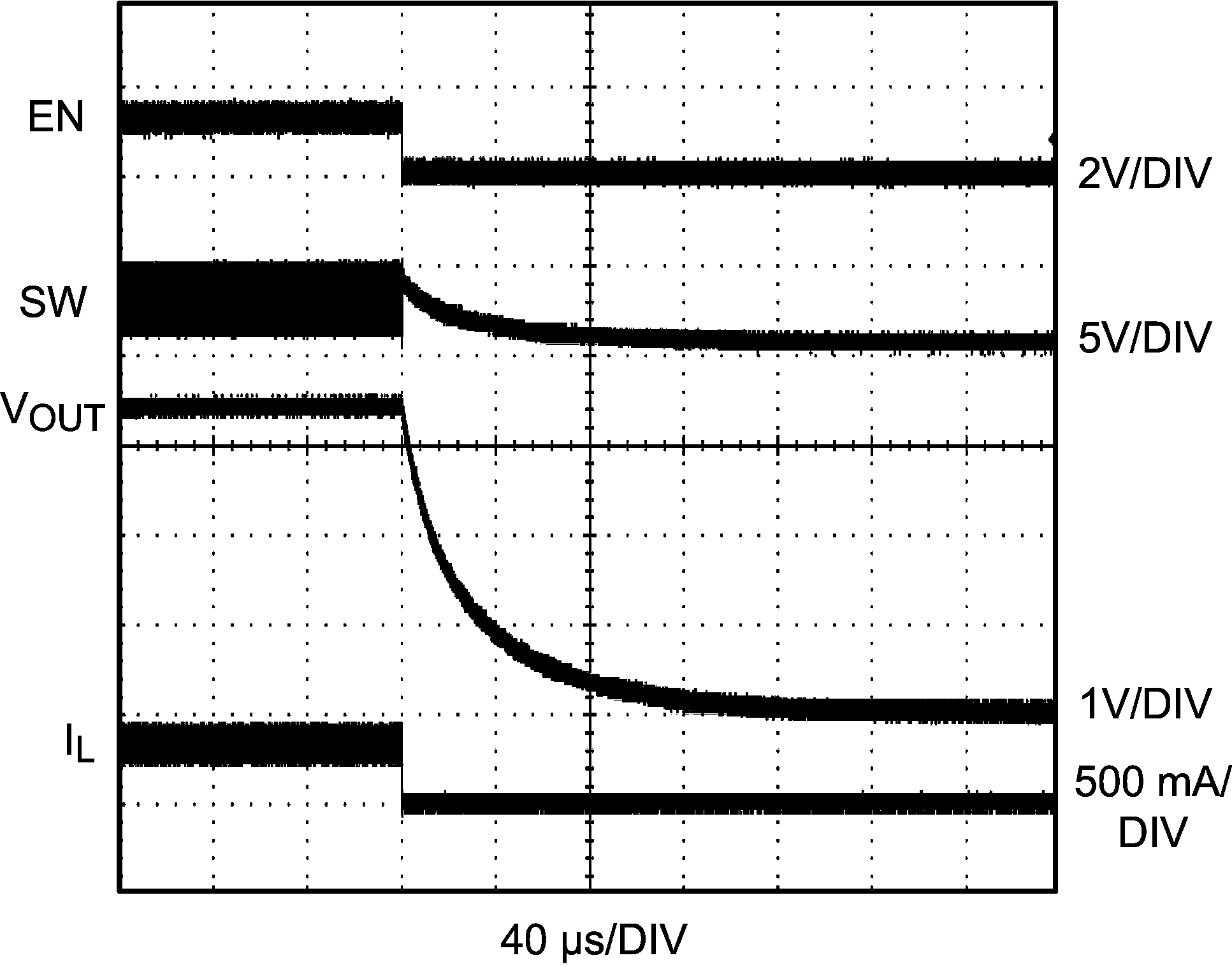
| VIN = 4.2 V | VOUT = 3.4 V | RLOAD = 10 Ω |
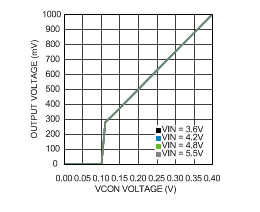
| RLOAD = 10 Ω |